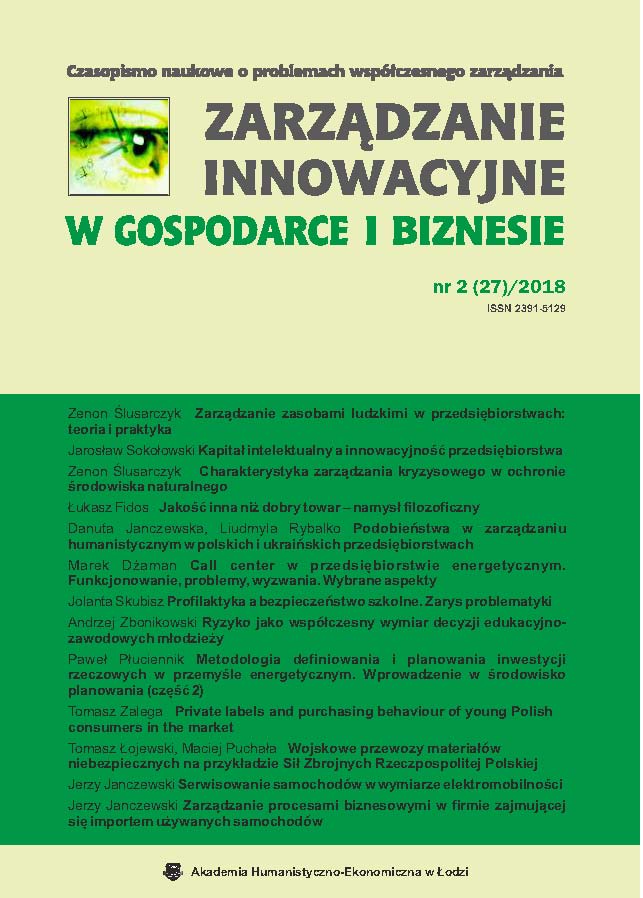Marki własne i producenckie a zachowania młodych konsumentów na rynku
DOI:
https://doi.org/10.25312/2391-5129.27/2018_10tzSłowa kluczowe:
marka własna, marka handlowa, młodzi konsumenci, zachowania konsumenckieAbstrakt
Początkowo marki własne kojarzono z niską jakością i nieznanym składem. Dzięki innowacjom produktowym coraz trudniej odróżnić produkt marki własnej sieci handlowej od tzw. marki masowej, czyli wytwarzanej dla ogółu populacji i dostępnej dla każdego konsumenta. W tym aspekcie istotne jest dostosowanie produktu do oczekiwań konsumenta. Asortyment produktów oferowanych pod markami własnymi obejmuje produkty codziennego użytku, luksusowe, dietetyczne bądź ekologiczne. Marki własne są jednym z najbardziej charakterystycznych elementów współczesnego handlu. Celem artykułu jest próba uchwycenia zachowań nabywczych polskich młodych konsumentów w stosunku do marek własnych i producenckich. Wyjaśniono pojęcie i istotę marek własnych, kluczowe czynniki wpływające na postawę konsumentów wobec marki oraz zachowania nabywcze wobec marek własnych. Następnie skoncentrowano się na konceptualizacji badań oraz opisie próby badawczej i jej cechach charakterystycznych. W oparciu o badania własne podjęto się próby uchwycenia zachowań nabywczych polskich młodych konsumentów wobec marek własnych.
Pobrania
Bibliografia
Abril C., Rodriguez-Cánovas B. (2016), Marketing mix effects on private labels brand quality, “European Journal of Management and Business Economics”, Vol. 15(3), pp. 168–175.
Beristain J.J., Zorrilla P. (2011), The relationship between store image and store brand equity: A conceptual framework and evidence from hypermarkets, “Journal of Retailing and Consumer Services”, No. 18, pp. 562–574.
Bigné E., Borredá A., Miquel M.J. (2013), El valor del establecimiento y su relación con la imagen de marca privada: efecto moderador del conocimiento de la marca privada como oferta propia del establecimiento, “Revista Europea de Dirección y Economía de la Empresa”, Vol. 22(1), pp. 1–10.
Calvo-Porral C., Lévy-Mangín J.P. (2014), Private labels brands: Major perspective of two consumer-based brand equality models, “International Review of Retail, Distribution and Consumer Research”, Vol. 24 (2), pp. 1–22.
Cuneo A., Lopez P., Yague M.J. (2012), Measuring private labels brand equality: A consumer perspective, “European Journal of Marketing”, Vol. 46(7/8), pp. 952–964.
Cyran K. (2016), Postrzeganie marek własnych produktów żywnościowych a perspektywy ich rozwoju (The perception of private labels of food products vs. the prospects for their development), „Prace Naukowe Uniwersytetu Ekonomicznego we Wrocławiu. Polityka Ekonomiczna”, nr 450, pp. 114–124.
Deloitte (2014), The 2014 American Pantry Study, New York.
Domański T. (2001), Strategie marketingowe dużych sieci handlowych (Marketing strategies of large retail chains), Wydawnictwo Naukowe PWN, Warszawa.
Euromonitor International (2014), The new face of private label: global market trends to 2018, Press Center, London.
Fall-Diallo M., Kaswengi J., Gázquez-Abad J.C. (2015), The Role of Previous Experience and Marketing Policy on Consumer Behaviour Towards Different Private Label Categories, [in:] F.J. Martínez-López, J. Gázquez-Abad, K. Ailawadi, M. Yagüe-Guillén (eds.), Advances in National Brand and Private Label Marketing, Springer Proceedings in Business and Economics, Springer International Publishing, Cham, Switzerland.
Fornerino M., d’Hauteville F. (2010), How good does it taste? Is it the product or the brand? A contribution to brand equity evaluation, “Journal of Product & Brand Management”, Vol. 19 (1), pp. 34–43.
Gilbert D. (1995), Retail Marketing Management, Pearson Education, Harlow.
Goldsmith R.E., Flynn L.R., Goldsmith E., Stacey, E.C. (2010), Consumer attitude and loyalty toward private brands, “International Journal of Consumer Studies”, Vol. 34, pp. 339–348.
Gómez-Suárez M., Quiñones M., Yagüe-Guillén M.J. (2017), Private Label Research: A Review of Consumer Purchase Decision Models, [in:] F. Martínez-López, J. Gázquez-Abad, K. Ailawadi, M. Yagüe-Guillén M. (eds.), Advances in National Brand and Private Label Marketing, Springer Proceedings in Business and Economics, Springer International Publishing Switzerland.
Horvat S., Ozretić-Došen D. (2015), Implementation of the Product Life Cycle Concept in Private Label Management: Focus on the Growth Stage, [in:] F.J. Martinez-López, J. Carlos Gázquez-Abad, R. Sethuraman (eds.), Advances in National Brand and Private Label Marketing, Second International Conference, Springer International Publishing Switzerland.
Kucharska B. (2017), Lojalność klienta – wyzwanie dla przedsiębiorstw handlu detalicznego (Customer loyalty – challenges for retail enterprises), „Handel Wewnętrzny”, Vol. 5(370), pp. 5–13.
Leppänen H., Grönroos Ch. (2009), Hybrid Consumer. Exploring the Drivers of a New Consumer Behaviour Type, Hanken School of Economics, Working Papers, No. 543.
Lubańska A. (2011), Znaczenie marek własnych sieci handlowych w Polsce (Role of retailer’s own brands on the Polish market), Zeszyty Naukowe SGGW w Warszawie, „Ekonomika i Organizacja Gospodarki Żywnościowej”, nr 87, pp. 475–483.
Łukasik P., Schivinski B. (2015), Determinanty zakupu marek własnych sieci handlowych przez polskich konsumentów (Determinants of purchase of private labels of commercial chains by Polish consumers), „Handel Wewnętrzny”, Vol. 5(358), pp. 5–23.
Mieres C., Martín A.M.D., Díaz Gutiérrez A.M., Trespalacios J.A. (2006), Antecedents of the difference in perceived risk between store brands and national brands, “European Journal of Marketing”, Vol. 40(1/2), pp. 61–82.
Molinillo S. et al. (2016), Private label management: Insights and research directions, [in:] Handbook of Research on Strategic Retailing of Private Label Products in a Recovering Economy, IGI Global, Pennsylvania, pp. 1–27.
Pepe M.S., Abratt R., Dion P. (2011), The impact of private label brands on customer loyalty and product category profitability, “Journal of Product & Brand Management”, Vol. 20(1), pp. 27–36.
Nielsen report (2018), The rise and rise again of private label, The Nielsen Company, US.
Rossi P., Borges A., Bakpayev M. (2015), Private labels versus national brands: The effects of branding on sensory perceptions and purchase intentions, “Journal of Retailing and Consumer Services”, Vol. 22(1), pp. 96–106.
Rostek A., Zalega T. (2015), Smart shopping wśród młodych polskich i amerykańskich konsumentów (Smart shopping among young Polish and American consumers), „Zarządzanie Innowacyjne w Gospodarce i Biznesie”, Vol. 1(22), pp. 177–199.
Sankowska A. (2011), Wpływ zaufania na zarządzanie przedsiębiorstwem. Perspektywa wewnątrzorganizacyjna (The impact of trust on company management. An in-house perspective), Difin, Warszawa.
Sethuraman R., Gielens K. (2014), Determinants of store brand share, “Journal of Retailing”, Vol. 90(2), pp. 141–153.
Simões C., Dibb S. (2001), Rethinking the brand concept: New brand orientation, “Corporate Communications: An International Journal”, Vol. 6(4), pp. 217–224.
Stanton J.L., Wiley J., Hooker N.H., Salnikova E. (2015), Relationship of product claims between private label and national brands: The influence of private label penetration, “Journal of Retail & Distribution Management”, Vol. 43(9), pp. 815–830.
Pobrania
Opublikowane
Numer
Dział
Licencja
Prawa autorskie (c) 2019 Akademia Humanistyczno-Ekonomiczna w Łodzi

Utwór dostępny jest na licencji Creative Commons Uznanie autorstwa – Na tych samych warunkach 4.0 Miedzynarodowe.



